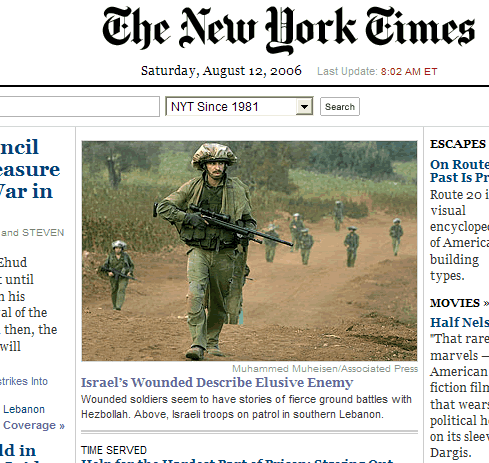August 12, 2006
Truth in captions?
In this morning's online New York Times, the text under the picture at the top of the page puzzled me:

The story that the picture and caption link to ("Israel's Wounded Describe Surprisingly Fierce, Well-Organized and Elusive Enemy", by Greg Myre, August 12, 2006) is a straightforward set of human-interest interviews with wounded soldiers in a Haifa hospital. So why does the caption tell us that "Wounded soldiers seem to have stories of fierce ground battles with Hezbollah"? Why not just put "Wounded soldiers have stories etc." under the picture on the front page?
Journalists and their editors seem to have several different motivations for adding words like seem. Sometimes it seems to be a signal that the unqualified statement may not be true, or at least seems to have no source other than the journalist's own observation.
(link) Whether in Toronto or London, police and spies seem to be getting more adept at handling "homegrown" terrorism cells.
Sometimes it seems to flag outright disbelief, whether on the part of the news outlet or of a third party:
(link) Some people protest that the “bang for the buck” they get from their pay packets seems to fall faster than reported inflation rates suggest; that money does not go as far as the official numbers say it should.
But Greg Myre's interviews don't seem to deserve either kind of qualification. Seasoned observers know that when journalists seem to paraphrase or even quote from interviews, even with named subjects, the results can be randomly inaccurate, and often present the story that the journalist wanted to tell rather than what the interview subjects actually said. Sometimes this even happens to quotes from powerful individuals in the context of important stories about interviews whose transcripts are independently available. But I'm not used to seeing this problem recognized, even implicitly, on the front page of the New York Times.
[Seriously, I guess that this seem was meant to indicate that Myre's story presents a sample of interviews, not a scientific survey. And I have no reason to believe that Myre's selection was misleading -- though the point of his story is a common thread in recent reporting from the Lebanese war, and I think we can assume that he had the shape of his story in mind before he began interviewing the wounded soldiers in Haifa, and selected from his interview notes in view of the points he wanted to make.]
[Update -- John Cowan wrote to suggest that the caption editor was adapting this sentence from the body of the story: "There are dozens of wounded soldiers here in northern Israel's main hospital, and all seem to have stories of unexpectedly fierce ground battles with Hezbollah." John's comment:
He simply botched it: it should have been either "All wounded soldiers seem to have stories" or (better) "Wounded soldiers have stories".
John also reminded us of what Hamlet told his mother: "Seems, madam? Nay, it is: I know not 'seems'", which John described as "a very famous linguification, the more interesting for being flatly self-contradictory". ]
Posted by Mark Liberman at August 12, 2006 09:03 AM